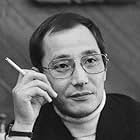Peacock King: Spirit Warrior - Festival of Ogres' Revival
Original title: Kujaku ô: Kikansai
- Episode aired Apr 29, 1988
IMDb RATING
6.2/10
17
YOUR RATING
Hiroya Ishimaru
- Onimaru
- (voice)
James Stanley
- Siegfried von Mittgard
- (English version)
- (voice)
- Director
- Writers
- All cast & crew
- Production, box office & more at IMDbPro
Storyline
Did you know
- ConnectionsVersion of Spellcaster (1988)
Featured review
FESTIVAL OF OGRES' REVIVAL (1988) was the first volume in a series of five anime adaptations (1988-94) of the Peacock King ("Kujaku-O") manga by Makoto Ogino. The plots of the first three volumes focus on the spirits of key Japanese historical figures being reborn to wreak havoc on modern Japan by taking over the souls of vulnerable young mediums. It is one of the most consistently imaginative series of occult thrillers in Japanese animation and offers the standard hard-edged appeal of the genre--demons, monsters, bloodshed, nudity, possession, etc.--along with an immersion in Japanese cultural history and superior artwork and design.
The hero is Kujaku, a young Buddhist monk and an acknowledged reincarnation of the Peacock King of ancient lore, who is allied with Jiku, his venerated master, and Ashura, Jiku's young granddaughter and a budding occultist herself. Kujaku also forms an uneasy alliance with another spirit warrior, Onimaru, a hulking, well-armed leather-clad biker who is referred to as a spirit mercenary and a warrior of forbidden curses and who generally uses his dark powers on the side of good.
In this first episode, Kujaku is assigned to retrieve a statue of Ashura, not his partner but one of the ancient Eight Guardians of Buddha, although a connection between young Ashura and her ancient counterpart is eventually revealed. The statue had been stolen from a well-guarded temple by Tatsuma, a student and amateur occultist hoping to use it to awaken his dormant psychic powers and save him years of study with a master. The statue turns out to contain the spirit of Abeno Seimei, the most powerful sorcerer in Japan's history, which had been sealed in it back in 1005. Possessing Tatsuma's body, Seimei seeks to return control of Japan to its sorcerers. Only Kujaku and his two partners, Ashura and Onimaru, have the power to stop these mad plans.
Of all five Peacock King volumes, this one is easily the most straightforward and concisely written. (The script is by Noboru Aikawa, who's also known for his work on VAMPIRE PRINCESS MIYU and THE HAKKENDEN, among many other anime series.) It's still quite complicated at times, but seems far less so compared to the detail-packed screenplays of the four later volumes. It's also got simpler artwork and more realistic design than the later episodes, as well as elegant, painterly backgrounds depicting some of Japan's traditional cultural sites and sacred grounds, especially around Kyoto.
There are demons galore, mostly designed in the traditional Japanese manner, and there is some sexual content and bloodshed, although the sex-violence-and-monster quotient is considerably amplified in later volumes, particularly the second installment, CASTLE OF ILLUSION. The plot device of invoking a notorious figure from Japan's history seems to reflect either discomfort with aspects of Japan's past behavior or guilt of some sort over the directions taken by Japan in the modern era. It's a prime illustration of a common theme of anime, the battle between the traditional and the modern, and it's not always clear which side the animators are on.
The other PEACOCK KING volumes include CASTLE OF ILLUSION, A HARVEST OF CHERRY BLOSSOMS, SPIRIT WARRIOR 1: REVIVAL OF EVIL and SPIRIT WARRIOR 2, all of which are reviewed on this site.
In 1989, there was also a live-action film, PEACOCK KING, co-produced by Hong Kong and Japan and starring HK kung fu star Yuen Biao. It was much more casually plotted, and was generally lighter-hearted in tone, with some charm and humor on display along with a host of clever special effects, including stop-motion animated monsters.
The hero is Kujaku, a young Buddhist monk and an acknowledged reincarnation of the Peacock King of ancient lore, who is allied with Jiku, his venerated master, and Ashura, Jiku's young granddaughter and a budding occultist herself. Kujaku also forms an uneasy alliance with another spirit warrior, Onimaru, a hulking, well-armed leather-clad biker who is referred to as a spirit mercenary and a warrior of forbidden curses and who generally uses his dark powers on the side of good.
In this first episode, Kujaku is assigned to retrieve a statue of Ashura, not his partner but one of the ancient Eight Guardians of Buddha, although a connection between young Ashura and her ancient counterpart is eventually revealed. The statue had been stolen from a well-guarded temple by Tatsuma, a student and amateur occultist hoping to use it to awaken his dormant psychic powers and save him years of study with a master. The statue turns out to contain the spirit of Abeno Seimei, the most powerful sorcerer in Japan's history, which had been sealed in it back in 1005. Possessing Tatsuma's body, Seimei seeks to return control of Japan to its sorcerers. Only Kujaku and his two partners, Ashura and Onimaru, have the power to stop these mad plans.
Of all five Peacock King volumes, this one is easily the most straightforward and concisely written. (The script is by Noboru Aikawa, who's also known for his work on VAMPIRE PRINCESS MIYU and THE HAKKENDEN, among many other anime series.) It's still quite complicated at times, but seems far less so compared to the detail-packed screenplays of the four later volumes. It's also got simpler artwork and more realistic design than the later episodes, as well as elegant, painterly backgrounds depicting some of Japan's traditional cultural sites and sacred grounds, especially around Kyoto.
There are demons galore, mostly designed in the traditional Japanese manner, and there is some sexual content and bloodshed, although the sex-violence-and-monster quotient is considerably amplified in later volumes, particularly the second installment, CASTLE OF ILLUSION. The plot device of invoking a notorious figure from Japan's history seems to reflect either discomfort with aspects of Japan's past behavior or guilt of some sort over the directions taken by Japan in the modern era. It's a prime illustration of a common theme of anime, the battle between the traditional and the modern, and it's not always clear which side the animators are on.
The other PEACOCK KING volumes include CASTLE OF ILLUSION, A HARVEST OF CHERRY BLOSSOMS, SPIRIT WARRIOR 1: REVIVAL OF EVIL and SPIRIT WARRIOR 2, all of which are reviewed on this site.
In 1989, there was also a live-action film, PEACOCK KING, co-produced by Hong Kong and Japan and starring HK kung fu star Yuen Biao. It was much more casually plotted, and was generally lighter-hearted in tone, with some charm and humor on display along with a host of clever special effects, including stop-motion animated monsters.
- BrianDanaCamp
- Aug 7, 2002
- Permalink
Details
Contribute to this page
Suggest an edit or add missing content

Top Gap
What is the broadcast (satellite or terrestrial TV) release date of Peacock King: Spirit Warrior - Festival of Ogres' Revival (1988) in Australia?
Answer









